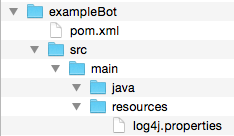Vediamo velocemente come creare un Bot per Telegram scritto in Java, usando JTeleBot.
Struttura file:
pom.xml
[code lang=”xml”]
<project xmlns="http://maven.apache.org/POM/4.0.0" xmlns:xsi="http://www.w3.org/2001/XMLSchema-instance" xsi:schemaLocation="http://maven.apache.org/POM/4.0.0 http://maven.apache.org/xsd/maven-4.0.0.xsd">
<modelVersion>4.0.0</modelVersion>
<groupId>org.example</groupId>
<artifactId>hello-word-bot</artifactId>
<version>1.0.0-SNAPSHOT</version>
<packaging>jar</packaging>
<properties>
<project.build.sourceEncoding>UTF-8</project.build.sourceEncoding>
</properties>
<dependencies>
<dependency>
<groupId>io.github.nixtabyte.telegram</groupId>
<artifactId>jtelebot-core</artifactId>
<version>0.1.0</version>
</dependency>
<dependency>
<groupId>log4j</groupId>
<artifactId>log4j</artifactId>
<version>1.2.17</version>
</dependency>
</dependencies>
</project>
[/code]
log4j.properties:
[code lang=”plain”]
log4j.rootLogger=INFO, CONSOLE
log4j.appender.CONSOLE=org.apache.log4j.ConsoleAppender
log4j.appender.CONSOLE.layout=org.apache.log4j.PatternLayout
log4j.appender.CONSOLE.layout.ConversionPattern= %d{HH:mm:ss,SSS} [%t] %-5p %x %C{1} : %m%n
[/code]
Nella cartella contenente i sorgenti Java…
HelloWorldCommand Class:
[code lang=”java”]
package org.example.helloworld;
import io.github.nixtabyte.telegram.jtelebot.client.RequestHandler;
import io.github.nixtabyte.telegram.jtelebot.exception.JsonParsingException;
import io.github.nixtabyte.telegram.jtelebot.exception.TelegramServerException;
import io.github.nixtabyte.telegram.jtelebot.request.TelegramRequest;
import io.github.nixtabyte.telegram.jtelebot.request.factory.TelegramRequestFactory;
import io.github.nixtabyte.telegram.jtelebot.response.json.Message;
import io.github.nixtabyte.telegram.jtelebot.server.impl.AbstractCommand;
public class HelloWorldCommand extends AbstractCommand {
public HelloWorldCommand(Message message, RequestHandler requestHandler) {
super(message, requestHandler);
}
@Override
public void execute() {
try {
TelegramRequest telegramRequest = TelegramRequestFactory.createSendMessageRequest(message.getChat().getId(), "Ciao Mondo!", true, message.getId(), null);
requestHandler.sendRequest(telegramRequest);
} catch (JsonParsingException | TelegramServerException e) {
e.printStackTrace();
}
}
}
[/code]
HelloWorldCommandFactory Class:
[code lang=”java”]
package org.example.helloworld;
import org.apache.log4j.Logger;
import io.github.nixtabyte.telegram.jtelebot.client.RequestHandler;
import io.github.nixtabyte.telegram.jtelebot.response.json.Message;
import io.github.nixtabyte.telegram.jtelebot.server.Command;
import io.github.nixtabyte.telegram.jtelebot.server.CommandFactory;
public class HelloWorldCommandFactory implements CommandFactory {
private static final Logger LOG = Logger.getLogger(HelloWorldCommandFactory.class);
@Override
public Command createCommand(Message message, RequestHandler requestHandler) {
LOG.info("MESSAGGIO: "+message.getText());
return new HelloWorldCommand(message,requestHandler);
}
}
[/code]
Main Class:
[code lang=”java”]
package org.example.helloworld;
import io.github.nixtabyte.telegram.jtelebot.server.impl.DefaultCommandDispatcher;
import io.github.nixtabyte.telegram.jtelebot.server.impl.DefaultCommandQueue;
import io.github.nixtabyte.telegram.jtelebot.server.impl.DefaultCommandWatcher;
public class Main {
public static void main(String []args){
DefaultCommandDispatcher commandDispatcher = new DefaultCommandDispatcher(10,100, new DefaultCommandQueue());
commandDispatcher.startUp();
DefaultCommandWatcher commandWatcher = new DefaultCommandWatcher(2000,100,"INSERISCI IL TUO TOKEN QUI",commandDispatcher,new HelloWorldCommandFactory());
commandWatcher.startUp();
}
}
[/code]
PS:non dimenticare di inserire il tuo token in questo file.
